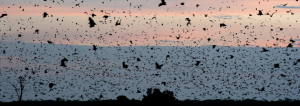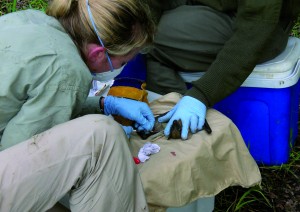THURSDAY, 1 OCTOBER 2009
Into AfricaWading thigh-deep through a murky swamp at 4 am, with reeds reaching far above my head and vegetation squishing through my waterproof walking shoes isn’t my ideal Sunday morning, but it certainly beats lab work!
This particular adventure took place in a small patch of mushitu forest in Kasanka National Park. As one of Zambia’s smallest national parks, it offers extraordinary diversity of bird life and unique opportunities to witness species that are rare in other parts of Africa. But I was there for different reasons. Every year, from a particular day in late October until the beginning of January, several million straw-coloured fruit bats (Eidolon helvum) descend on this small patch of mushitu forest within the park.
These fruit bats are widely distributed across sub-Saharan Africa, with easily recognisable colonies: it’s hard to miss a squabbling roost consisting of millions of individuals, especially since they are often found in the busiest parts of major cities. It’s thought that they migrate seasonally to make the most of variations in fruit availability. The colony at Kasanka is the largest known.
It’s an awe-inspiring sight to watch the bats leave the roost to feed. Shortly before dusk falls, black silhouettes pepper the African sky as far as the eye can see.
I was there to collect blood and genetic samples from a few of the vast population. Each morning, my guide Changwe and I waited for the colony to return from their night time feeding, before the heat of the day arrives and when the bats are weary from their night time activities.
I am part of a collaboration investigating the role of the fruit bat as a host for viruses that can infect humans. Lagos Bat Virus (a rabies-type virus) had been found in this species before, but in colonies in Ghana, Malawi and Zambia, we have also found a Henipavirus (a new genus of viruses in the same family as measles). These viruses had only been found previously in Australia, Asia and Madagascar, where transmission from bats to humans has resulted in fatalities. Human cases have not been reported in Africa, even though the colonies are in close proximity to humans and are a common source of bush meat. However, this could be due to misdiagnosis and is an important area for future research.
To truly understand how the viruses circulate within and between colonies, more information on the migratory patterns and connectivity of colonies across Africa is needed. For example, little is known about where the individuals in the Kasankan colony come from, or how they manage to arrive with such remarkable accuracy year on year.
My research addresses this by comparing genetic samples from colonies across the whole continent. Results so far point to one freely mixing population across continental sub-Saharan Africa. However, some isolated island populations in the Gulf of Guinea appear to be genetically distinct from the mainland population. Comparing the infection status of these colonies with those on the mainland could give us vital insight into the circulation of the viruses.
It appears that fruit bats have evolved with these viruses over millions of years and that ‘spillover’ transmission to other species, including humans, may result from an ongoing loss of their natural habitat and other man-made environmental changes. Further research will help us to understand the enigmatic lifestyle of these fascinating fruit bats, so that we can minimise human health risks, whilst maintaining the natural and crucial role that these bats play in the ecosystem.
Alison Peel is a PhD student in the Department of Veterinary Medicine
Physics Busking
Samuel Wright recounts his weekend as a magician at the Green Man Festival.
Music festivals are generally places where you can go to escape normality for a few days. The last thing you would probably expect to find is a group of scientists demonstrating experiments. This year I was part of a team of physicists who stepped up to the challenge at the Green Man Festival in Wales, by becoming ‘physics buskers’.
We were there as part of the Physics in the Field scheme, which is run by the Institute of Physics. Our goal was to perform physics tricks and raise awareness of physics amongst the festival goers, the majority of whom do not have scientific backgrounds and would not normally seek science out.
Our team of five was made up of four student volunteers and the coordinator Zbig. As an incentive to volunteer we were given free tickets for the festival and five meals a day. I met the other volunteers bright and early on the first morning, with no idea what to expect, as I had never taken part in physics busking before. We were all a little nervous, and the driving rain did not help! We were presented with a box full of balloons, bottles, film canisters, skewers, and a plethora of other common household artefacts.
Who would we appeal to, if indeed we appealed to anyone? Or would we disappear into the backdrop of the festival, only visited by the odd drifter on a mission to find a clean toilet? After all, could physics buskers really hope to compete with the musically acclaimed folk-tronica that had attracted the visitors in the first place?
The answer, to our amazement, was yes. We were at times overwhelmed by the number of people stopping by to catch a bit of science, in between the other amusements on offer. The response to our demonstrations was consistently positive from our onlookers, young and old. But our biggest fans were the youngest of our visitors. There were a large number of children at the festival and our magic tricks struck a chord with their imagination.
Our job as physics buskers was to demonstrate a physical principal by using basic everyday objects. We performed a little trick and then explained the science behind what we did. It was a real buzz to see the sheer bewilderment on the faces of our patrons as they pushed a skewer through a balloon without popping it, heard the drone of a vibrating coat hanger amplified by a string, or set off a rocket using just a tablet of alka seltzer.
I really enjoyed my weekend of physics busking. I have yet to meet a graduate student that has not, at some point, become disenchanted with their research, if not science as a whole. Taking part in schemes like this not only promotes and popularises our work, but also helps to remind us why we became interested in science in the first place. If the opportunity arises to take part in anything like this, then I recommend you give it a try. You won’t regret it.
More information about the Physics in the Field scheme as well as a detailed explanation of all the tricks and example movies can be found at www.physics.org/events
Samuel Wright is a PhD student in the Department of Physics




